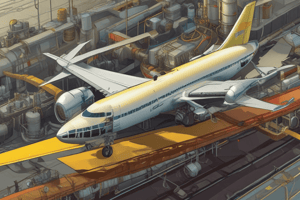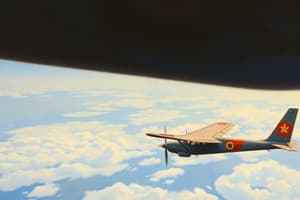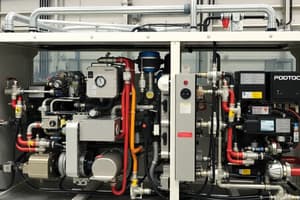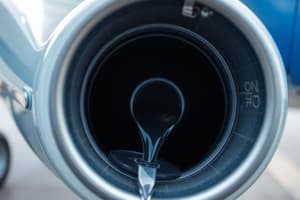Podcast
Questions and Answers
Who is acknowledged in the learning outcomes for their contributions to fuel development?
Who is acknowledged in the learning outcomes for their contributions to fuel development?
- The engineer who invented jet propulsion
- The person behind the development of fuel in aviation (correct)
- The inventor of the first aircraft
- The scientist who discovered aviation dynamics
What type of activities does the module include for student engagement?
What type of activities does the module include for student engagement?
- Enrichment activities and performance tasks (correct)
- Field trips to aircraft manufacturers
- Weekly quizzes and exams only
- Group projects exclusively
What is the primary focus of discussion in the fuel and lubricants module?
What is the primary focus of discussion in the fuel and lubricants module?
- The aesthetic designs of aircraft
- The historical timeline of aviation fuel (correct)
- The relevance of aerodynamics in racing
- The efficiency of different aircraft engines
What was the initial type of fuel used for aircraft engines before advancements were made?
What was the initial type of fuel used for aircraft engines before advancements were made?
Who realized the need for high-octane aviation fuel before World War II?
Who realized the need for high-octane aviation fuel before World War II?
What is the primary quality of high-octane fuel that benefits piston engines?
What is the primary quality of high-octane fuel that benefits piston engines?
What kind of fuel did Doolittle convince Shell Oil Company to manufacture?
What kind of fuel did Doolittle convince Shell Oil Company to manufacture?
Why was high-octane fuel significant for the performance of U.S. aircraft engines in World War II?
Why was high-octane fuel significant for the performance of U.S. aircraft engines in World War II?
During the early periods of aviation fuel refinement, what percentage of refined petroleum was high-octane aviation gas?
During the early periods of aviation fuel refinement, what percentage of refined petroleum was high-octane aviation gas?
What was one of the main differences between U.S. aircraft engines and those of the German Luftwaffe during World War II?
What was one of the main differences between U.S. aircraft engines and those of the German Luftwaffe during World War II?
What was the role of Major Jimmie Doolittle at Shell Oil Company in relation to aviation fuel?
What was the role of Major Jimmie Doolittle at Shell Oil Company in relation to aviation fuel?
Who first collected crude oil and refined petroleum for fuel?
Who first collected crude oil and refined petroleum for fuel?
What significant fuel was developed in the British Isles between the 1600s and 1700s?
What significant fuel was developed in the British Isles between the 1600s and 1700s?
Which fuel was first associated with cooking and heating in China around 2500 BC?
Which fuel was first associated with cooking and heating in China around 2500 BC?
In which period did the use of charcoal become commonplace for smelting tin and copper?
In which period did the use of charcoal become commonplace for smelting tin and copper?
What temperature can charcoal burn at, making it suitable for metallurgical processes?
What temperature can charcoal burn at, making it suitable for metallurgical processes?
What was a major factor that spurred the development of higher-performance engines for aircraft?
What was a major factor that spurred the development of higher-performance engines for aircraft?
When was the first definite evidence of man's involvement with charcoal as a fuel found?
When was the first definite evidence of man's involvement with charcoal as a fuel found?
Which material was commonly used for making fire by Homo Erectus about 2 million years ago?
Which material was commonly used for making fire by Homo Erectus about 2 million years ago?
What is the primary role of transitions between paragraphs in an essay?
What is the primary role of transitions between paragraphs in an essay?
How is the level of content assessed in an essay?
How is the level of content assessed in an essay?
Which statement best describes the development of ideas in a high-quality essay?
Which statement best describes the development of ideas in a high-quality essay?
What effect do grammatical errors have on an essay?
What effect do grammatical errors have on an essay?
What indicates a higher degree of critical thinking in essay writing?
What indicates a higher degree of critical thinking in essay writing?
Which characteristic is typical of an essay with low content quality?
Which characteristic is typical of an essay with low content quality?
What should be minimized to ensure effective communication in writing?
What should be minimized to ensure effective communication in writing?
What distinguishes original thinking in an essay?
What distinguishes original thinking in an essay?
Flashcards are hidden until you start studying
Study Notes
Introduction to Fuel and Lubricants
- Aviation fuel is crucial for aircraft engine performance and development, paralleling other technological advancements in aviation.
- Pioneering efforts in aviation fuel began in the 1930s, led by influential figures recognized for their contributions in research and development.
History of Fuel
- Fuel usage dates back 2 million years with Homo Erectus using sticks and wood for fire.
- 3,500 BC: Evidence of charcoal usage as fuel discovered in Southern Europe and the Middle East.
- 2,500 BC: Coal burning documented in China for cooking and heating purposes.
- 2,000 BC: Charcoal became widely used in British bronze production, reaching temperatures over 1000°C.
- 1 AD: Crude oil was first collected and refined in China for lamps.
- 1600-1700s: British innovate by cooking coal into coke, a significant fuel source for industries in subsequent centuries.
Key Figures in Aviation Fuel Development
- Major Jimmie Doolittle was instrumental in advocating for aviation fuel advancements before WWII.
- Advocated for high-octane aviation gas, leading to the creation of 100-octane fuel, known as Aviation Gasoline (AvGas).
- Doolittle's efforts ensured the U.S. had sufficient high-quality fuel at the onset of WWII, enhancing aircraft performance over German counterparts.
Octane Ratings and Fuel Efficiency
- Fuel rating is based on the octane level; higher octane ensures efficient combustion in piston engines.
- Before Doolittle's advocacy, most gasoline had an 87 octane rating, inadequate for powerful piston engines used in military aircraft.
- The development of high-performance fuels spurred advancements in aircraft engine technology.
Learning Outcomes
- Recognize the historical context and technological advancements related to aviation fuels.
- Understand the significance of individual contributions to fuel development in aviation.
Enrichment Activity
- Assess the historical timeline of fuel invention and notable contributors to aviation gas developments through structured writing.
Essay Rubric Overview
- Evaluates organization, content, critical thinking, development, and grammar, highlighting levels from inadequate to exemplary in scholarly writing.
Studying That Suits You
Use AI to generate personalized quizzes and flashcards to suit your learning preferences.




